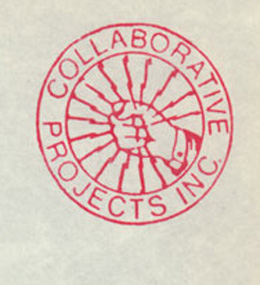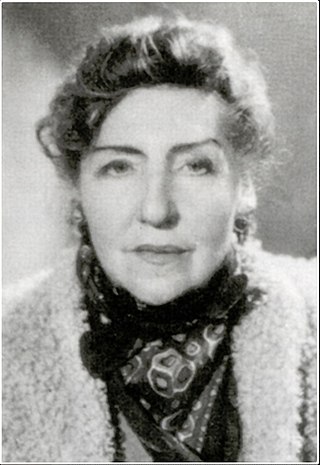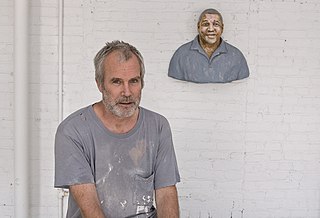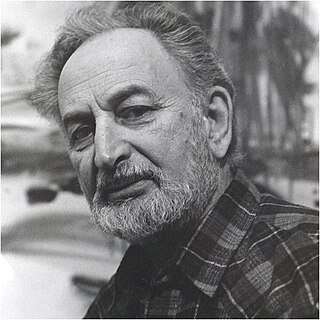Related Research Articles
Karsten Schubert was a German art dealer and publisher working in London.

Alex Katz is an American figurative artist known for his paintings, sculptures, and prints. Since 1951, Katz's work has been the subject of more than 200 solo exhibitions and nearly 500 group exhibitions throughout the United States and internationally. He is well known for his large paintings, whose bold simplicity and heightened colors are considered as precursors to Pop Art.

Colab is the commonly used abbreviation of the New York City artists' group Collaborative Projects, which was formed after a series of open meetings between artists of various disciplines.

Betty Parsons was an American artist, art dealer, and collector known for her early promotion of Abstract Expressionism. She is regarded as one of the most influential and dynamic figures of the American avant-garde.

Yvonne Helene Jacquette was an American painter, printmaker, and educator. She was known in particular for her depictions of aerial landscapes, especially her low-altitude and oblique aerial views of cities or towns, often painted using a distinctive, pointillistic technique. Through her marriage with Rudy Burckhardt, she was a member of the Burckhardt family by marriage. Her son is Tom Burckhardt.

David Zwirner Gallery is an American contemporary art gallery owned by David Zwirner. It has four gallery spaces in New York City and one each in Los Angeles, London, Hong Kong, and Paris.

David Zwirner is a German art dealer and owner of the David Zwirner Gallery in New York City, Los Angeles, London, Hong Kong, and Paris.
William Clutz was an American artist known for urban paintings, pastels, and charcoal drawings of pedestrian scenes transformed by light. He was associated with a revival in figurative representation in American art during the 1950s and 1960s.
Sarah Brayer is an American artist who works in both Japan and the United States. She is internationally known for her poured washi paperworks, aquatint and woodblock prints. In 2013 Japan's Ministry of Culture awarded Sarah its Bunkacho Chokan Hyosho for dissemination of Japanese culture abroad through her creations in Echizen washi. She currently resides in Kyoto, Japan and New York, U.S.A.
Robin Winters is an American conceptual artist and teacher based in New York. Winters is known for creating solo exhibitions containing an interactive durational performance component to his installations, sometimes lasting up to two months. As an early practitioner of Relational Aesthetics Winters has incorporated such devices as blind dates, double dates, dinners, fortune telling, and free consultation in his performances. Throughout his career he has engaged in a wide variety of media, such as performance art, film, video, writing prose and poetry, photography, installation art, printmaking, drawing, painting, ceramic sculpture, bronze sculpture, and glassblowing. Recurring imagery in his work includes faces, boats, cars, bottles, hats, and the fool.

The Real Estate Show was a short-term occupation art exhibition held on New Year's Day in a vacant city-owned building at 123 Delancey Street in the Lower East Side of Manhattan, New York City by New York artists' group Colab. As stated in “The Real Estate Show Manifesto or Statement of Intent”, the subject of the exhibition was resistance to abusive landlord speculation within the real estate industry.
Margo Humphrey is an American printmaker, illustrator and art teacher. She earned a Master of Fine Arts degree from Stanford after earning a Bachelor of Fine Arts degree at the California College of Arts and Crafts in printmaking. She has traveled in Africa, Brazil, the Caribbean, and Europe and has taught in Fiji, Nigeria, Uganda, and the University of Maryland. As a printmaker, she is known for her "bold, expressive use of color and freedom of form", creating works that are "engaging, exuberant and alive." Her work is considered to be "in the forefront of contemporary printmaking."

Ethel Mars was an American woodblock print artist, known for her white-line woodcut prints, also known as Provincetown Prints, and a children's book illustrator. She had a lifelong relationship with fellow artist Maud Hunt Squire, with whom she lived in Paris and Provincetown, Massachusetts.

Eric Ian Hornak-Spoutz is an American art dealer, historian and museum curator. Spoutz has owned art galleries in Detroit, Michigan, Cape Coral, Florida, Palm Beach, Florida, and Los Angeles, California.

John Ahearn is an American sculptor. He is best known for the public art and street art he made in South Bronx in the 1980s.
Richard Bosman is an American artist, educator, and illustrator. Bosman is best known for his paintings and prints. His work is often related to crime, adventure, and disaster narratives; rural Americana; and nature and domestic themes. He is associated with the Neo-expressionist movement of the late 1970s and early 1980s. Bosman was a member of Colab, the New York artist collective founded in 1977, and participated in the group's influential, “Times Square Show” (1980).

The Times Square Show was an influential collaborative, self-curated, and self-generated art exhibition held by New York artists' group Colab in Times Square in a shuttered massage parlor at 201 W. 41st and 7th Avenue during the entire month of June in 1980. The Times Square Show was largely inspired by the more radical Colab show The Real Estate Show, but unlike it, was open 24 hours a day, 7 days a week, in what was then a Times Square full of porno theaters, peep shows, and red light establishments. In addition to experimental painting and sculpture, the exhibition incorporated music, fashion, and an ambitious program of performance and video. For many artists the exhibition served as a forum for the exchange of ideas, a testing-ground for social-directed figurative work in progress, and a catalyst for exploring new political-artistic directions.

Hugh Mesibov was an American abstract expressionist artist who began his career as a federal artist for the Works Progress Administration during the Great Depression and later became a member of the 10th Street galleries and part of the New York School during the 1940s-60s. His work has elements of the mid-20th-century New York artistic experience such as Surrealist and Abstract Expressionist and figurative aspects across several media such as watercolor, oil, and acrylic as well as etchings, lithographs and monoprints. His work has received a global reputation and is included in many collections in the United States and worldwide.
This is a timeline of 20th-century printmaking in America.
Alexander Raoul Stavenitz was a Russian Empire-born American visual artist and educator. He was known for his paintings, and printmaking. He also worked as an industrial designer and architectural designer in his early career.
References
- ↑ Brooke Alexander, Inc. listing at The Art Dealers Association of America (ADAA) a nonprofit membership organization of the nation's leading galleries in the fine arts
- ↑ Brooke Alexander Gallery Overview at Pitchbook
- ↑ "Brooke Alexander, Inc". Artnet . Retrieved August 10, 2020.
- ↑ "Modern Galleries Drawn to Soho" by Douglas C. McGill The New York Times September 17, 1985
- ↑ Grace Glueck (September 24, 1982). "ART: AFTER 2 YEARS, 'SELECTED PRINTS III'". The New York Times . Retrieved August 11, 2020.
- ↑ "Inside Art" by Carol Vogel September 10, 1993 The New York Times
- ↑ Lubow, Arthur (January 7, 2018). "The Business of Being David Zwirner". The Wall Street Journal . Retrieved August 14, 2018.
- ↑ "Peter Alexander, who created ethereal worlds out of resin, dies at 81". Los Angeles Times . May 28, 2020. Retrieved August 10, 2020.
- ↑ Ted Bonin, New York Art Dealer Who Co-founded a Beloved Gallery, Dies at 65 by Alex Greenberger April 4, 2023
- ↑ Proponent of American Printmaking Published on 13 June 2022, by Vanessa Schmitz-Grucker
- ↑ How Brooke and Carolyn Alexander launched a 50-year print empire driven by expert connoisseurship, Christies
- ↑ New York’s Alexander and Bonin Gallery Shutters After 28 Years by Alex Greenburger at Art News
- ↑ Brooke Alexander Archive Cards at 98 Bowery
- 1 2 For 25 years: Brooke Alexander editions: the Museum of Modern Art, New York, the Tatyana Grosman Gallery, January 27-May 17, 1994 at the Smithsonian Libraries
- ↑ "Colab Redux installation". Archived from the original on June 22, 2013. Retrieved August 20, 2013.
- ↑ Colab Redux PR